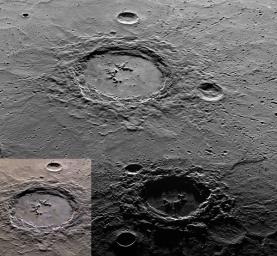
|
Three Views of Hokusai
- Click the image above for a larger view
- Full-Res JPEG (1342 x 1240) (419.5 kB)
- Full-Res TIFF (1342 x 1240) (5.0 MB)
Caption:
Today's image shows three oblique mosaics of Hokusai , a complex crater in Mercury's northern hemisphere. The top mosaic features a view of Hokusai where north is to the left. The bottom left is a color mosaic that also has north to the left. In the bottom right is mosaic with a high incidence angle where north is now to the right. The high incidence angle emphasizes topography differences because the sun's low angle creates long shadows. Evident in all of these mosaics are Hokusai's smooth impact melt covered floor , central peak , ejecta blanket , and terraced walls .
The top mosaic was acquired as a high-resolution targeted observation. Targeted observations are images of a small area on Mercury's surface at resolutions much higher than the 200-meter/pixel morphology base map. It is not possible to cover all of Mercury's surface at this high resolution, but typically several areas of high scientific interest are imaged in this mode each week.
The bottom left color image was acquired as a targeted high-resolution 11-color image set. Acquiring 11-color targets is a new campaign that began in March 2013 and that utilizes all of the WAC's 11 narrow-band color filters. Because of the large data volume involved, only features of special scientific interest are targeted for imaging in all 11 colors.
The bottom right mosaic was acquired as part of MDIS's high-incidence-angle base map. The high-incidence-angle base map complements the surface morphology base map of MESSENGER's primary mission that was acquired under generally more moderate incidence angles. High incidence angles, achieved when the Sun is near the horizon, result in long shadows that accentuate the small-scale topography of geologic features. The high-incidence-angle base map was acquired with an average resolution of 200 meters/pixel.
Instruments:
Wide Angle Camera (WAC) and Narrow Angle Camera (NAC) of the Mercury Dual Imaging System (MDIS)
WAC filters:
9, 7, 6 (996, 748, 433 nanometers) in red, green, and blue for color mosaic
Center Latitude:
57.66°
Center Longitude:
16.58° E
Scale:
Hokusai is about 85 km (53 miles) in diameter.
Background Info:
The MESSENGER spacecraft is the first ever to orbit the planet Mercury, and the spacecraft's seven scientific instruments and radio science investigation are unraveling the history and evolution of the Solar System's innermost planet. During the first two years of orbital operations, MESSENGER acquired over 150,000 images and extensive other data sets. MESSENGER is capable of continuing orbital operations until early 2015.
For information regarding the use of images, see the MESSENGER image use policy .
Cataloging Keywords:
| Name | Value | Additional Values |
|---|---|---|
| Target | Mercury | |
| System | ||
| Target Type | Planet | |
| Mission | MESSENGER | |
| Instrument Host | MESSENGER | |
| Host Type | Orbiter | |
| Instrument | Mercury Dual Imaging System (MDIS) | |
| Detector | Narrow Angle Camera (NAC), Wide Angle Camera (WAC) | |
| Extra Keywords | Color, Crater, Impact, Map, Radio, Shadow | |
| Acquisition Date | ||
| Release Date | 2014-08-20 | |
| Date in Caption | ||
| Image Credit | NASA/Johns Hopkins University Applied Physics Laboratory/Carnegie Institution of Washington | |
| Source | photojournal.jpl.nasa.gov/catalog/PIA18683 | |
| Identifier | PIA18683 | |
